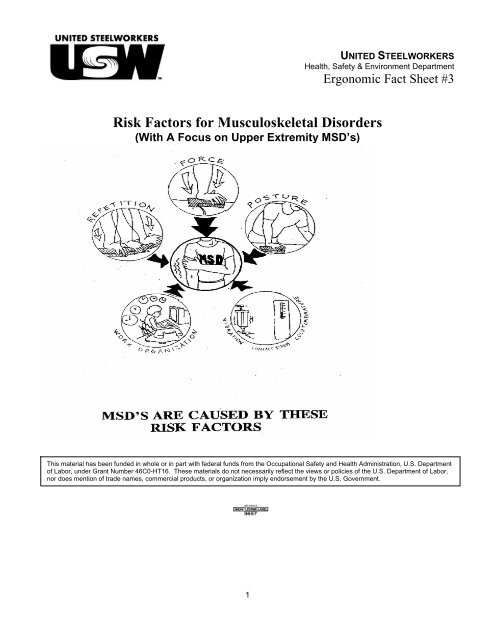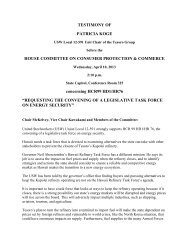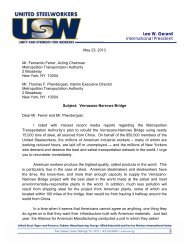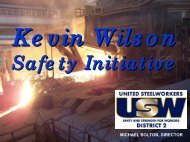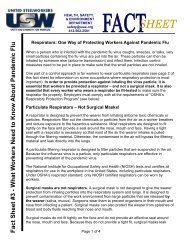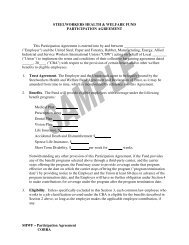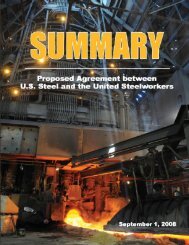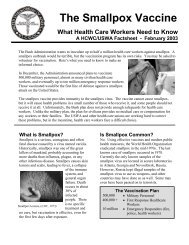Ergonomic Fact Sheet #3 - United Steelworkers
Ergonomic Fact Sheet #3 - United Steelworkers
Ergonomic Fact Sheet #3 - United Steelworkers
You also want an ePaper? Increase the reach of your titles
YUMPU automatically turns print PDFs into web optimized ePapers that Google loves.
UNITED STEELWORKERSHealth, Safety & Environment Department<strong>Ergonomic</strong> <strong>Fact</strong> <strong>Sheet</strong> <strong>#3</strong>Risk <strong>Fact</strong>ors for Musculoskeletal Disorders(With A Focus on Upper Extremity MSD’s)This material has been funded in whole or in part with federal funds from the Occupational Safety and Health Administration, U.S. Departmentof Labor, under Grant Number 46C0-HT16. These materials do not necessarily reflect the views or policies of the U.S. Department of Labor,nor does mention of trade names, commercial products, or organization imply endorsement by the U.S. Government.1
UNITED STEELWORKERSHealth, Safety & Environment Department<strong>Ergonomic</strong> <strong>Fact</strong> <strong>Sheet</strong> <strong>#3</strong>Risk factors for musculoskeletal disorders are aspects of a job or working conditions thatincrease workers’ risks of being injured. Any one of the following risk factors, or acombination of them, can cause a musculoskeletal disorder:FORCE: Force is a load or pressure that can cause damage to various body parts andtissues. Force is present when you are pushing, pulling or lifting something. Forces onyourarms, shoulders, back and legs can affect tendons, blood vessels, nerves, muscles and othersoft tissues. Using a "pinch grip" with your fingers instead of a "power grip" with your fistputs three to four times more "force" on tendons in the fingers and hands. Forces are notonly problems for those dealing with heavy weights. Keying on a keyboard repeatedlyexposes soft tissues in the fingers and hands to forces that can be damaging.REPETITION: Doing the same motion over and over again without adequate rest in theform of breaks -- even mini-breaks -- “overuses” the same muscles, tendons, and other softtissues. Job tasks done repeatedly require the same muscles to contract over and over. Ifthe pace of work is increased (as in "speed-up"-- where workers are supposed to get moreand more work done in shorter periods of time, or where one worker is doing the job oftwo) the number of repetitions increases. This adds that much more wear and tear to softtissues. These body parts can, in turn, "wear out," and permanent damage can result.POSTURE (AWKWARD OR STATIC):• Awkward: Certain jobs or tasks may require you to work in an awkward position,such as:• working with your arms over your head;• twisting, bending and/or reaching (which can be made even moreproblematic if you are handling a heavy object);• working with a bent back, bent wrist, or bent knees.2
UNITED STEELWORKERSHealth, Safety & Environment Department<strong>Ergonomic</strong> <strong>Fact</strong> <strong>Sheet</strong> <strong>#3</strong>• Jobs, workstations and tasks that force workers to work for extended periodsof time with their wrists bent, or with a "pinch grip", or with their arms aboveshoulder height are jobs where workers are exposed to risk factors formusculoskeletal injuries.• So too are jobs that require workers to reach behind the "midline" of the bodyor require workers to work with an "inward” or "outward" rotated position ofthe elbow. These are all considered "non-neutral" postures.• The goal is to design tools, workstations and tasks so that workers can workin neutral postures.• Static: Some jobs may require you to work in a static posture, where you arein one position for a prolonged period of time (sitting, standing, kneeling).Working in these postures can, over time, hurt muscles, tendons and other softtissues.3
UNITED STEELWORKERSHealth, Safety & Environment Department<strong>Ergonomic</strong> <strong>Fact</strong> <strong>Sheet</strong> <strong>#3</strong>CONTACT STRESS: An example of contact stress is when a tool handle or edge digsinto the soft tissue of the palm of the hand. Another example is when a job task requiresyou to use your hand as a hammer. This puts pressure on soft tissues and results in damageto those tissues.VIBRATION: The vibration from some tools such as jack hammers can damage the softtissue in the shoulder, arm and hand. Vibration can also be transmitted to the whole bodyfrom the ground or from the seat of a vehicle. The vibration can damage soft tissue in theback.COLD TEMPERATURE: Working in a cold temperature can damage soft tissue that isexposed to the cold.Work OrganizationWorkers’ risk of developing musculoskeletal disorders is affected by the way in whichwork is organized, or work organization. Work organization is often defined as “the socialaspects of work that organize how things are done, by whom, with what, how often, howlong, etc.”Work organization includes factors such as: pace of work, workload, staffing levels, hoursof work, supervision, production quotas, deadlines, and number and length of rest breaks.How work is organized can increase (or decrease) workers’ exposure to risk factors formusculoskeletal disorders. For example, if the speed of an assembly line is increased tomaximize production, this will often increase the number of repetitive motions workers onthat assembly line will have to perform. Working under deadlines or production quotas cancause muscles to tense up, adding to "wear and tear" on soft tissues and increasing the riskof musculoskeletal disorder.The Result of Exposure to Risk <strong>Fact</strong>ors for Musculoskeletal DisordersExposure to risk factors for musculoskeletal disorders often results in workers working inpain. If wear and tear reaches a certain point, disability can result. This can affect not onlya worker's ability to work, but also to do other activities such as opening a jar, chopping anonion, driving a car, lifting a child, turning a door knob, getting dressed, and holding a4
UNITED STEELWORKERSHealth, Safety & Environment Department<strong>Ergonomic</strong> <strong>Fact</strong> <strong>Sheet</strong> <strong>#3</strong>toothbrush. In severe cases of musculoskeletal disorders, this damage can be permanent(irreversible).5


